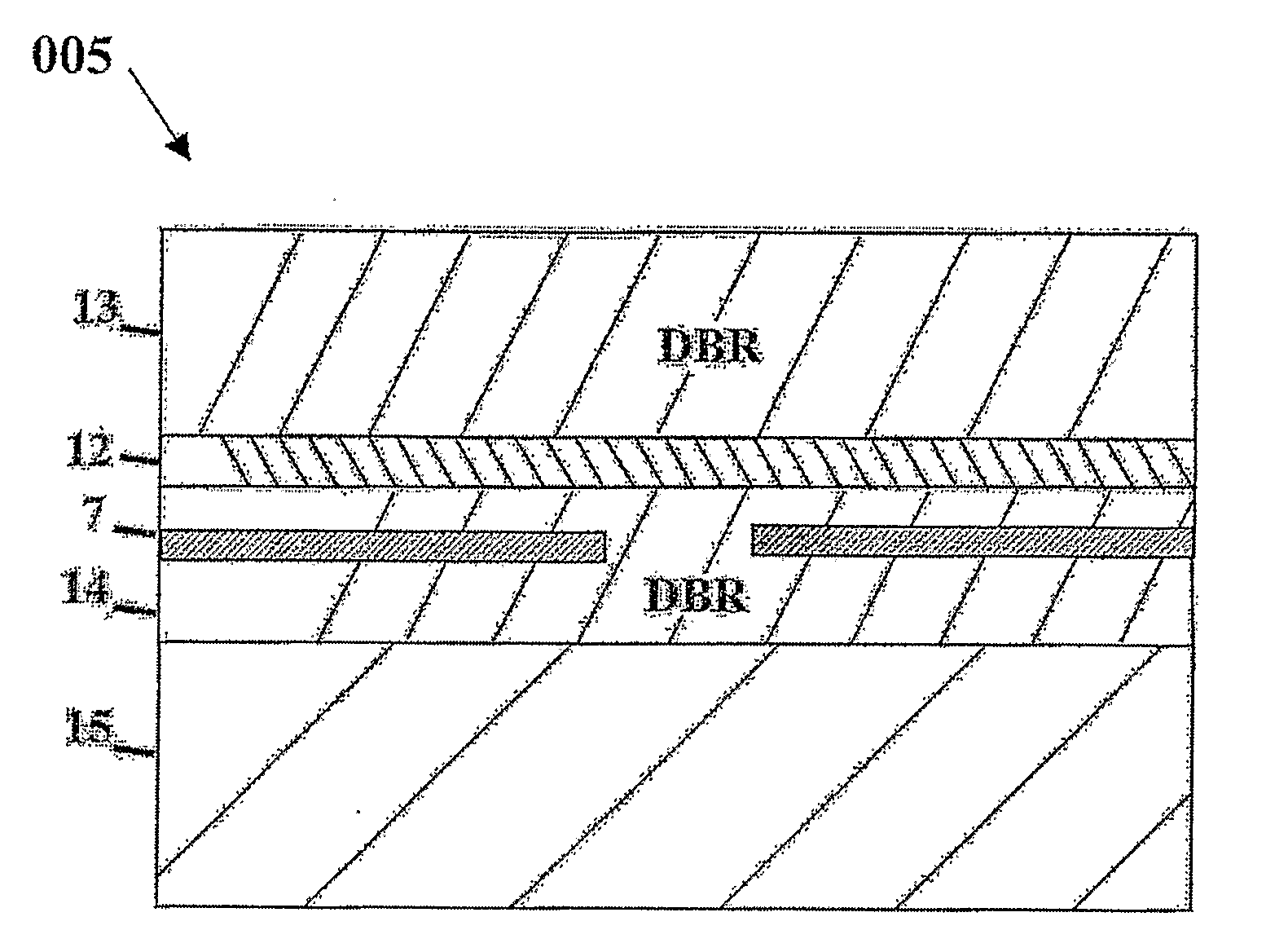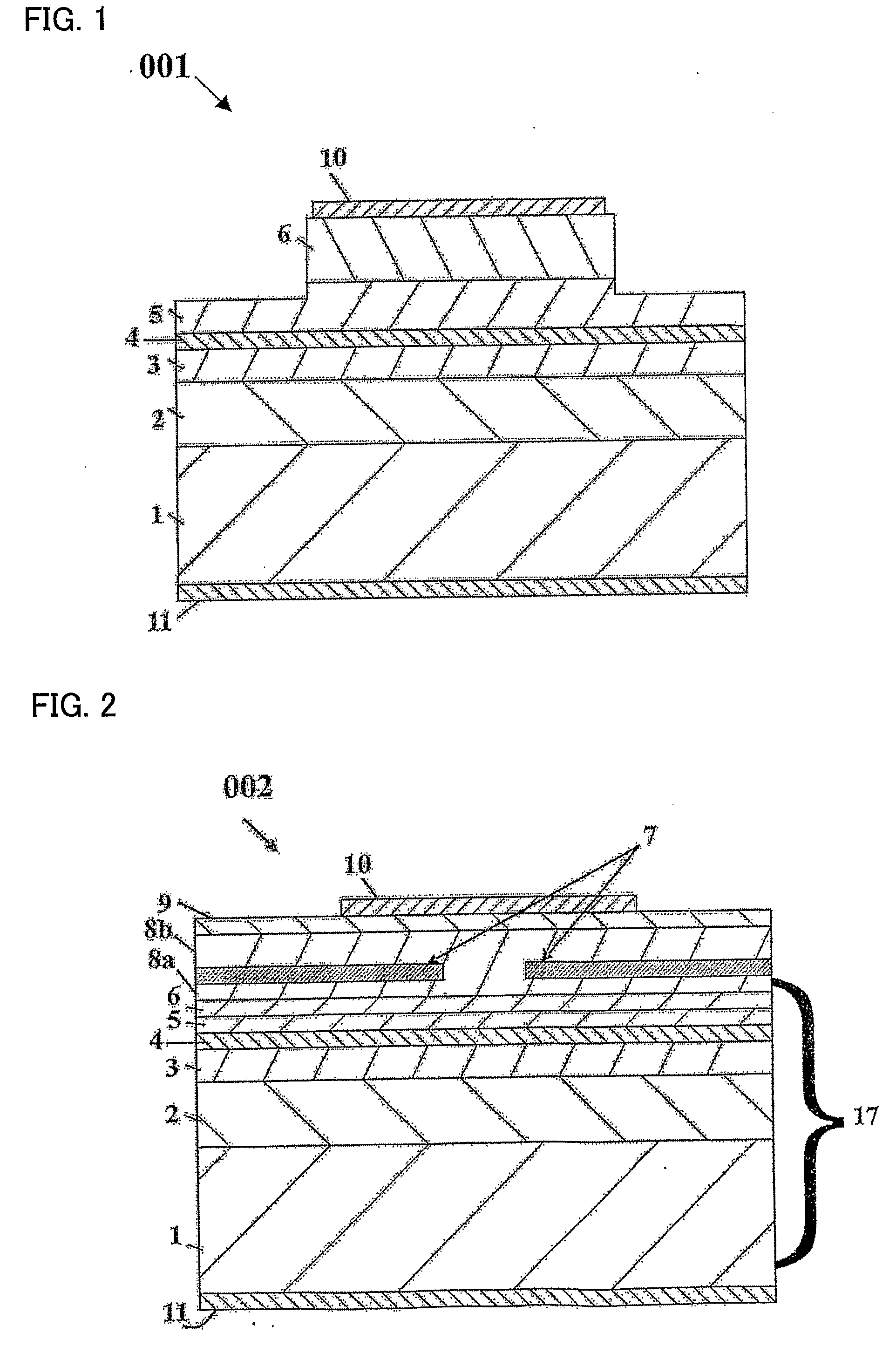Semiconductor layer structure
a semiconductor layer and semiconductor technology, applied in the direction of semiconductor devices, lasers, semiconductor lasers, etc., can solve the problems of the ridge ld efficiency, the ratio of output optical power to input electrical energy, and the well known limits of the output power of the waveguide laser diode, so as to reduce the likelihood of defects and increase the electrical resistance
- Summary
- Abstract
- Description
- Claims
- Application Information
AI Technical Summary
Benefits of technology
Problems solved by technology
Method used
Image
Examples
first embodiment
[0043]FIG. 2 shows a cross-sectional structure of a semiconductor laser 002 according to a first embodiment of the invention. The semiconductor laser 002 is also defined here as p-SAS. The semiconductor laser 002 includes a substrate, in this example a n-type GaN semiconductor substrate 1, and plurality of semiconductor layers which include a multilayer structure 17 having an active region for light-emission over the substrate. In the example of FIG. 2 the multilayer structure 17 includes a n-type AlGaN cladding layer 2, a n-type GaN guide layer 3, a multiple quantum well active region 4 containing In, a nominally undoped GaN guide layer 5, a p-type AlGaN carrier blocking layer 6, a p-type AlGaN cladding layer 8. The role of layer 6 is to prevent electron leakage from the active region. This layer is standard in nitrides semiconductor laser. A p-type GaN contact layer 9 is grown over the p-type AlGaN cladding layer 8. On the top surface of the contact layer 9 is a p-electrode 10 and...
second embodiment
[0051]FIG. 5 shows a cross-sectional structure of a semiconductor laser diode 003 as a second embodiment of this invention. This semiconductor laser 003 is also called an n-SAS (self-aligned structure) laser diode. The semiconductor laser 003 includes a substrate, in this example a n-type GaN semiconductor substrate 1, and a multilayer structure including an active region for light-emission over the substrate. A current confinement layer 7 is provided in this multilayer structure. The second embodiment differs from the first embodiment in that, while the current confinement layer 7 is formed on the top surface of the p-AlGaN carrier blocking layer 6 in the first embodiment, the current confinement layer 7 is placed on the top surface of the n-type cladding layer 2 in the second embodiment.
[0052]The AlInN current confinement layer 7 is formed on the top surface of the n-type AlGaN cladding layer 2. The n-type GaN guide layer 3 is in contact with the top surface of the layer 7 and wit...
third embodiment
[0054]This third embodiment is a method of forming a resistive AlInN layer with high crystal quality on a surface of (Al,Ga,In)N nitride semiconductor. First a semiconductor substrate with a top surface of an (Al,Ga,In)N nitride semiconductor is placed in an MBE deposition chamber (step 1 of FIG. 16). Then the substrate temperature is raised to a suitable growth temperature (step 2 of FIG. 16). For growth of AlInN, a substrate temperature of between 550degC and 650degC would be suitable. Activated nitrogen is then supplied to the substrate surface by the mean of a RF plasma cell (step 3 of FIG. 16). Then the growth is started by supplying aluminium and indium to the growth chamber (step of FIG. 16). This makes possible the growth of a crystalline AlInN layer having high crystal quality.
[0055]Journal of Applied Physics Vol. 82, p 5472 (1997) presents an overview of the growth conditions used in PA-MBE for the growth of GaN. It is now accepted and demonstrated that, in order to obtain...
PUM
 Login to View More
Login to View More Abstract
Description
Claims
Application Information
 Login to View More
Login to View More - R&D
- Intellectual Property
- Life Sciences
- Materials
- Tech Scout
- Unparalleled Data Quality
- Higher Quality Content
- 60% Fewer Hallucinations
Browse by: Latest US Patents, China's latest patents, Technical Efficacy Thesaurus, Application Domain, Technology Topic, Popular Technical Reports.
© 2025 PatSnap. All rights reserved.Legal|Privacy policy|Modern Slavery Act Transparency Statement|Sitemap|About US| Contact US: help@patsnap.com



